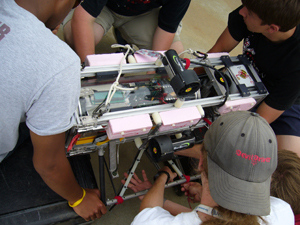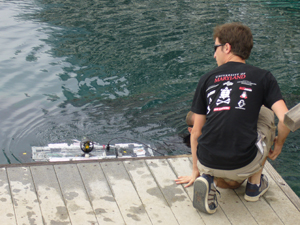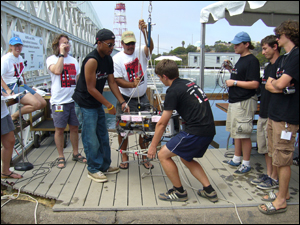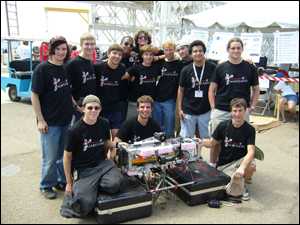Robotics at Maryland Makes a Splash: |
|
FOR IMMEDIATE RELEASE CONTACT: Missy Corley
A ROBOT THAT SWIMS
The Robotics@ Each team was challenged to design and build an AUV capable of navigating realistic underwater missions. The University of Maryland team entered the final round in first place among the eight finalists, and held on to win the competition in only its second year of participation. The University of Maryland's team of thirteen overcame many challenges during the competition.
"Despite losing our main vehicle computer, busting a thruster propeller, temporarily losing our firewire cameras, and watching three team member's laptops die (including mine), the group worked together and handled each problem in turn," said Joseph Gland, a graduate student advisor for the Robotics@Maryland team. The final competition included a range of tasks, including dead reckoning approximately 50 feet through the starting gate, pipeline following, buoy docking, tracking and hovering over an acoustic pinger, grabbing an object and surfacing with the object to a floating ring. The Robotics@Maryland team is made up of students from across the campus, including electrical, computer, aerospace, and mechanical engineering majors from the university's A. James Clark School of Engineering, plus physics, math and computer science majors. The team was assisted by two Clark School professors who served as faculty advisors for the student group: Prof. Dave Akin in aerospace engineering's Space Systems Lab and Prof. Nuno Martins in electrical and computer engineering and the Institute for Systems Research. The Robotics@Maryland team benefited from a particularly useful and unique facility at the Clark School's Neutral Buoyancy Research Facility in the Space Systems Laboratory on the University of Maryland campus—the only such university-based facility in the country. The 50-foot diameter, 25-foot deep water tank is used to simulate the microgravity environment of space. Prof. Akin allowed the student group to test their autonomous underwater robot, Tortuga II, at the facility, which proved a valuable environment for practicing the robot's maneuvering capabilities. The team is sponsored by campus Office of the Vice President for Research, the Department of Electrical and Computer Engineering, the Department of Aerospace Engineering, the Institute for Systems Research, and the Clark School of Engineering, and also receives corporate support from Clark School Corporate Partner BAE Systems, E.K. Fox and Apple, who donated the Mac Mini computer that was used to create and control Tortuga II. Memsense was also a sponsor, donating an Inertial Measurement Unit and other electronic hardware. Gaining increased support for their AUV project in the last year proved a key factor in the team's successful second attempt in the annual competition, which earned the students a $7,000 prize. Many of the Robotics@Maryland students have also taken advantage of courses at the University of Maryland designed to stimulate students' interest in solving open-ended problems, such as those involved in developing robots at the Clark School. "WHEN STUDENTS TAKE CONTROL OF A CLASS, IT'S AMAZING TO SEE HOW FAST WE COULD GO."
Gilmer Blankenship, professor of electrical and computer engineering (ECE), is experimenting with new and innovative teaching techniques in his senior-level course, "Autonomous Robotics." The course is one of the U-Md.'s Capstone Design Courses, which are intended to allow students to synthesize solutions to open-ended problems. In Blankenship’s course, students work in small teams to build and program robots to compete in performing specific tasks. The robots can be described technically as autonomous mobile sensor platforms, consisting of a truck-like frame and wheels, with an onboard laptop computer, making each robot approximately 15” x 20” in size. The students can communicate with the robots using wireless links and a remote desktop application, as well as other custom applications the students design. The emphasis of the course is on designing strategies and tactics, and programming the robots to succeed at challenging tasks, such as cooperating to pursue another robot, or racing around an obstacle course. The physical features of the robot platforms are much less important than their algorithms and software, which the student groups develop throughout the semester. To emphasize this, all of the robots are physically identical and have the same sensors to control movement. The course is unique in that it allows students to benefit from innovations accomplished by students previously enrolled in the course. Elements of the best student designs are carried over to the next semester’s class, so new students enrolled in the course build on a canon of knowledge, and start with software systems that have been successful at one or more tasks. This requires the new students to come up to speed on software written by someone else, a common task in real-world engineering design projects, reflecting the environment that the students will ultimately find in industry or research laboratory after graduation. "The experience has been extremely rewarding," said Scott Watson, a May 2008 computer engineering graduate, and a Robotics@Maryland team member. "When students take control of their own learning, it’s amazing to see how fast we can go. Surprisingly, another benefit of the class is that I realized the importance and potential application of all the theory that I’ve learned up to this point." Blankenship has introduced new problems into the course each semester that challenge students to innovate and create solutions to problems even he admits may not be solvable. For example, last year, Blankenship asked a team of students to develop a method for a ground robot to control an unstable aerial robot, creating a mechanism for the aerial robot to hover directly over the ground robot. Amazingly, a team of his students managed to accomplish this late one evening, well after midnight. They nearly called him in the middle of the night to announce their success. "I told them they should have called me," said Blankenship. "I am very glad to see that the challenges in this course have inspired this kind of enthusiasm from our students."
The enthusiasm that has developed from students engaged in robotics activities at University of Maryland helped lead to the involvement in a new regional robotics event, the first annual Autonomous Small Robot Speedway competition. The inaugural race is scheduled for Sept. 6 on the College Park campus. The event was conceived and organized by the Washington, DC Chapter of the Institute of Electrical and Electronic Engineers Robotics and Automation Society (IEEE-RAS) in conjunction with student members of Robotics@Maryland. The event is co-sponsored by IEEE-RAS, the University of Maryland's Department of Electrical and Computer Engineering, and Robotics Research, LLC, based in Gaithersburg, Md. The competition, which attracted seven teams for its inaugural event, will take place outdoors on campus. Each team’s autonomous robot will race around an array of traffic cones organized in an elliptical shape. "The technical challenges posed by this competition will inspire creative solutions by the participants and nurture an appreciation for hands-on engineering projects, thus bridging the gap between theory and practice," said IEEE-RAS representative Melanie Vida, lead organizer for the event. "It is an opportunity to develop an autonomous vehicle that integrates sensing, control and embedded computing." The robots' autonomous navigation will be comprised of obstacle avoidance, dead reckoning, telemetry, onboard sensor processing, computer vision, and dealing with uncertainty in environmental conditions such as uneven lighting conditions, uneven surface, and unevenly spaced cones. This systems engineering exercise will once again provide students at the University of Maryland, as well as from other teams engaged in the competition, an opportunity to practice an integrated, interdisciplinary approach to solving problems and optimizing performance. The students' vision for the Autonomous Robot Speedway race is to continue to grow the event each year with the goal of making it the premier outdoor robotics competition in the Mid-Atlantic region. More Information: AUV Competition: http://www.robotronics.org About the A. James Clark School of Engineering The Clark School's graduate programs are collectively the fastest rising in the nation. In U.S. News & World Report's annual rating of graduate programs, the school is 17th among public and private programs nationally, 11th among public programs nationally and first among public programs in the mid-Atlantic region. The School offers 13 graduate programs and 12 undergraduate programs, including degree and certification programs tailored for working professionals. The school is home to one of the most vibrant research programs in the country. With major emphasis in key areas such as communications and networking, nanotechnology, bioengineering, reliability engineering, project management, intelligent transportation systems and space robotics, as well as electronic packaging and smart small systems and materials, the Clark School is leading the way toward the next generations of engineering advances. Visit the Clark School homepage at www.eng.umd.edu. ###
|
|
||||||||||||||||||||||||||||||||||||||||||||||












